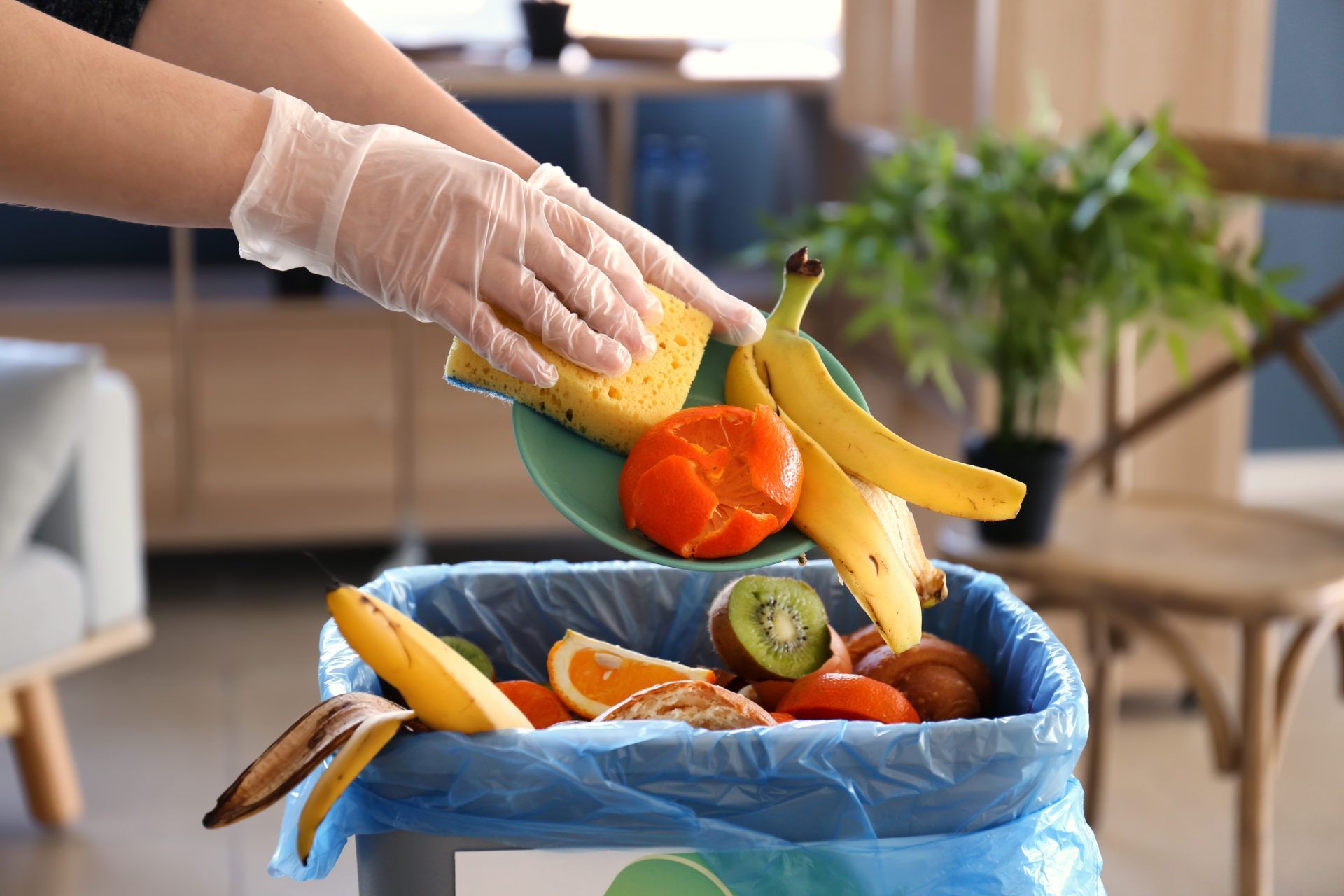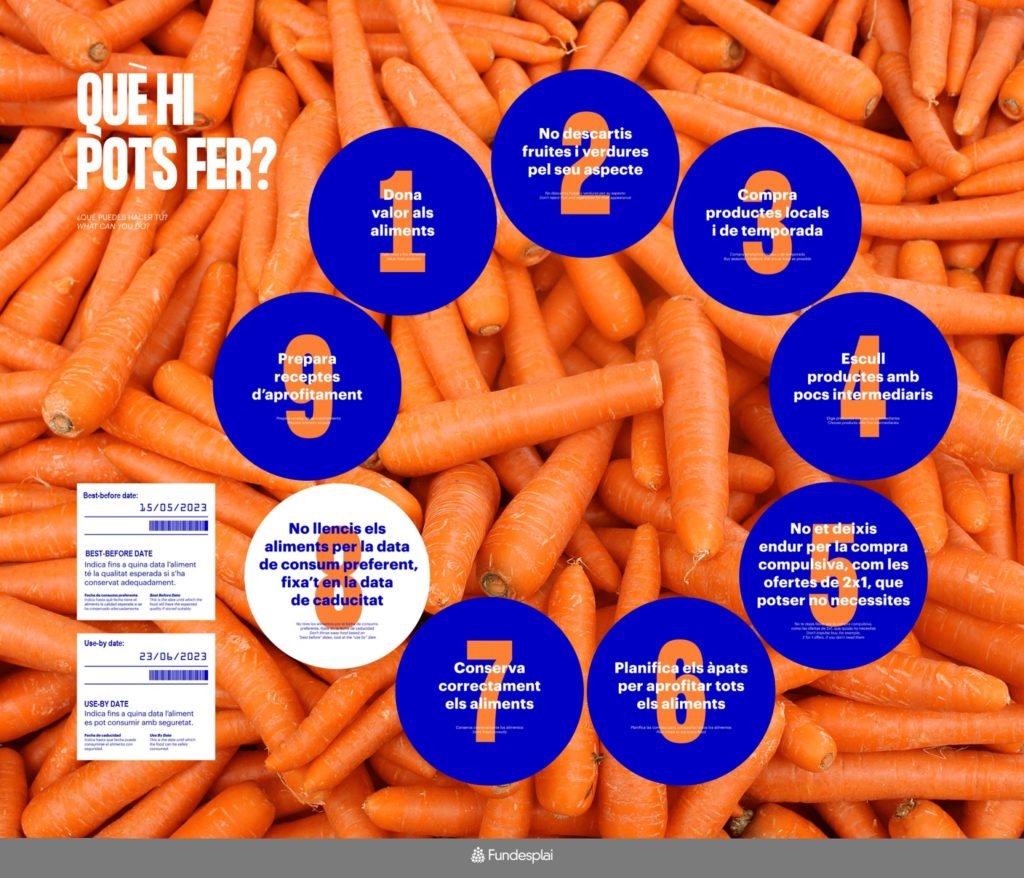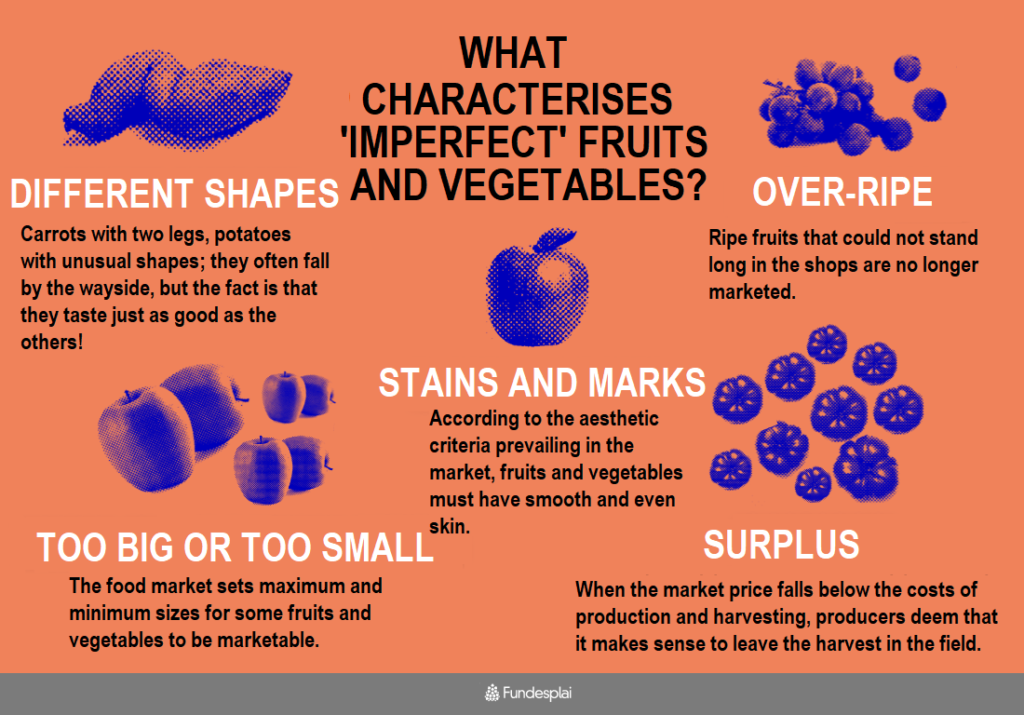
Appreciating the value of food, planning meals and avoiding compulsive shopping are some of our suggestions to prevent food waste.
Food-waste data are alarming: in Catalonia, each person wastes 35 kg of food per year, about 7% of what they buy.
Food waste implies a huge environmental cost since it accounts for 8-10% of greenhouse gas (GHG) emissions worldwide.
What can we do to fight against such a tremendous waste? Here we offer nine suggestions you may find of great use in your everyday life.

1. APPRECIATE THE VALUE OF FOOD
Ada Parellada talks extensively about the value we place on food. Avoiding food waste is one of the top priorities of her work. She says that, in recent years, there has been a very significant change in the clientele’s attitude towards the value of food. The cause is that all the awareness campaigns have taken hold: “Not completely and not in the whole population, but they are making their mark, and the message is consolidating”, she says.
“Ten years ago, throwing away food had a certain prestige, but not now: nowadays, throwing away food is a sin. We value food more: the normal thing is to be sustainable. It cannot be abnormal”, explains Parellada.
In addition, she says that rescuing shared meals at the table is essential to recover the value and love of food. She also suggests that we talk about what we eat at the table and share the value of the meals we prepare for others.
In her book La cuina sostenible [Sustainable cooking], Parellada states that bread is one of the most undervalued foods in catering. “We throw away food in a totally arbitrary and exaggerated manner.” Traditionally, the catering sector gives bread for free, so it is usually not of high quality. I wanted to change this trend, so I now charge for bread. This way, we reduced thrown-away bread by 70%.”
>Read the complete interview with Ada Parellada (or watch the relevant video here).
2. DON’T DISCARD FRUITS AND VEGETABLES FOR THEIR LOOKS
People at es im-perfect®, a brand of vegetable preserves committed to sustainability and social justice within a project of the Espigoladors Foundation, know a lot about food recovery.
They make vegetable pâtés, jams and sauces with local fruit and vegetables discarded from the commercial circuit because of aesthetic imperfections, price drops or production surpluses. At es-imperfect®, they give a new value to these fruits and vegetables through a model based on the principles of the circular economy..
WHAT ARE IMPERFECT FRUITS AND VEGETABLES LIKE?

- Different shapes: carrots with two legs, potatoes with unusual shapes; they often fall by the wayside, but the fact is that they taste just as good as the others!
- Over-ripe: ripe fruits that could not stand long in the shops are no longer marketed.
- Stains and marks: according to the aesthetic criteria prevailing in the market, fruits and vegetables must have smooth and even skin.
- Too big or too small: the food market sets maximum and minimum sizes for some fruits and vegetables to be marketable.
- Surplus: when the market price falls below the costs of production and harvesting, producers deem that it makes sense to leave the harvest in the field.
3. BUY LOCAL AND SEASONAL PRODUCE
As explained by the Health Channel of the Generalitat de Catalunya, locally grown food can be an environmentally friendly option as long as we choose produce that is in season in the area where we live.
In other words, the energy cost of producing and storing food outside its natural growing season can be higher than the cost of transporting food that is in season in more distant areas.
> Check out our blog for more articles on local and seasonal food.
4. CHOOSE PRODUCTS WITH FEW INTERMEDIARIES
Much of the food we eat travels across oceans to reach our plates. For example, the case of chickpeas: although they can be grown on the Iberian Peninsula, we import them in large quantities. The average distance between the farmer producing the chickpeas and the consumer buying them is 7,500 km. Alimentos Kilométricos (in Spanish) reports that it is a dispensable transoceanic trip since chickpeas have been locally grown for 40 years.
Yet, what does all this have to do with food waste? As explained in the guide “Un consum + responsable dels aliments” (“A more responsible food consumption”, in Catalan), local products help prevent food waste because of a more accurate regulation between supply and demand in sales centres. In addition, there are fewer probabilities of breaking the cold chain and the products ending up ruined.
> To learn more, read the article “From the garden to the plate”.
5. DON’T GET CARRIED AWAY BY COMPULSIVE BUYING, SUCH AS 2×1 OFFERS, WHICH YOU MAY NOT NEED.
As the Catalan Consumer Agency explains, it is important to avoid offers that do not fit in with the planning you have made and that make you buy more than you need.
The guide “Un consum + responsable dels aliments” (in Catalan) speaks about market strategies to transfer surpluses from distributors to consumers. By buying more than necessary, the result is often a waste of part of the product purchased.
6. PLAN MEALS TO MAKE THE MOST OF ALL THE FOOD
Mindless shopping can be very detrimental when it comes to food waste. Therefore, as explained in the document “Cuina d’aprofitament d’aliments”, [Food efficiency cooking”], thinking about the week’s menus before shopping can be very useful for buying the exact quantities.
In addition, checking the food in the fridge and pantry before shopping is also a must. Otherwise, you may buy products you already have and end up having to throw some of them away.
Only after these steps should we write the shopping list with everything we need.
> More information (in Catalan).
7. PRESERVE FOOD CORRECTLY
Maintaining the temperature conditions required for each food is a key factor in avoiding waste. As the explica l’Agència Catalana de Seguretat Alimentària [Catalan Food Safety Agency], explains, it is essential to follow the preservation instructions on the food label.
It also recommends checking the fridge frequently and freezing any food that starts to spoil if it cannot be consumed immediately. Contrary to what many people think, milk, cheese, sausages, vegetables and fruit can also be frozen!

As for the distribution of the food in the fridge, yoghurts, cheeses, cold meats, cooked and packaged foods and semi-preserved foods have to go on the top shelf.
If you follow a diet that includes animal protein, meat, fish, and seafood should be placed on the bottom shelf (they need to be at a lower temperature). As mentioned above, it is important that if you do not have to consume the meat or fish soon, freeze it to ensure that it does not spoil.
Finally, you must keep fruit and vegetables in the fridge’s drawers.
As for sauces, jams, drinks and eggs, they belong in the fridge door.
8. DON’T THROW AWAY FOOD BECAUSE OF THE BEST-BEFORE DATE; LOOK AT THE USE-BY DATE.
Do you know the difference between the best-before date and the use-by date? The product may still be safe to eat after the best-before date as long as you follow the storage instructions and the packaging is intact. However, after the best-before date, the food may start to lose flavour and texture.
On the other hand, the use-by date is the date until which you can safely consume the food. What if you freeze the food right after you buy it? It may be safe to consume it beyond the use-by date, provided you do it properly. You should strictly follow the instructions on the packaging: “cook without defrosting” or “put the food in the freezer until the use-by date”, for example.
So, before throwing away a product because the best-before date has passed, check that it looks, smells and tastes good and ensure the packaging is intact. If everything is intact, you can eat the food without worrying. It is also necessary to consider the storage instructions once you start the packaging, as recommended by the Catalan Food Safety Agency (in Catalan).
> Read the article “Debunking myths about food expiry dates” to know more about this topic. You will find a fun questionary!
9. PREPARE TRASH COOKING RECIPES
Food recycling is very present in Catalan cuisine, as explained in the document “Trash Cooking Recipes. Food is not thrown away” (in Catalan), curated by the Barcelona City Council.
Trash cooking recipes prevent that we throw away lots of food. Besides, they promote economic savings since they make use of food that otherwise would end up in the garbage bin.
Making the most of leftovers for making new, original and high-quality meals is one of the aims of this movement. There are also proposals for using parts of foodstuff generally thrown away.
> Take a look at the trash cooking recipes (in Catalan) offered by Som Gent de Profit
How did you like these suggestions and tips for fighting against food waste? Did you know all of them? Are you already using them in your everyday life?
Below are links to other articles from our blog that deal on food waste:
> El cost dels aliments que es malbaraten (in Catalan)
> L’entrevista: Ada Parellada (in Catalan)

